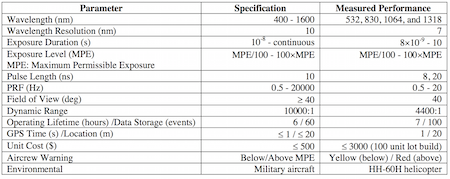Home
A comprehensive resource for safe and responsible laser use

2005 OPTRA laser event recorder testing
The following are selected excerpts from the document Ground and Air Test Performance of the Laser Event Recorder.
Abstract
“The primary objective of this effort is to develop a low-cost, self-powered, and compact laser event recorder and warning sensor for the measurement of laser events. Previously[*] we reported on the technology and design of the Laser Event Recorder. In this paper we describe results from a series of ground and airborne tests of the Laser Event Recorder.”
Introduction
“The Laser Event Recorder (LER) has been developed in response to the need for accurate laser exposure information. The LER is a low-cost, self-powered laser sensor that detects the presence of a laser illumination; extracts irradiance, wavelength, pulse duration, pulse repetition frequency, time and location of exposure, and an image of the scene containing the laser; warns personnel as to whether the exposure level poses a hazard to eye safety; and saves the exposure and scene information to a file that can be downloaded for analysis.”
Test results
“The LER correctly captured all three laser sources in the various test scenarios during three days and nights of flight testing. Occasional false alarms were recorded due to direct viewing of the sun. Also, while ambient temperatures above 40 C did not result in false alarms it did occasionally corrupt laser event statistics due to increased sensor noise.”
Summary
“OPTRA, Inc. has successfully designed, developed, built, and tested a laser event recorder towards the objectives established by NAVAIR. The LER was proven suitable for use in ground and air applications through a series of outdoor tests culminating in the detection of continuous visible and pulse infrared lasers in flight aboard an HH-60H helicopter through the cooperation of NHRC Detachment Brooks City-Base and Naval Strike and Air Warfare Center.”
“Table 4 shows a summary of the measured performance compared to the original set of specifications. Work continues towards optimizing the accuracy of radiant exposure, detection rate and false alarm rejection, maximization of dynamic range, and aircraft mounting options. Testing also continues in support of military applications such as high energy laser development. Delivery of updated LER units to the US Navy is planned for later this year.”

__________
*Previous (2004) paper: Craig R. Schwarze ; Robert M. Vaillancourt ; David L. Carlson ; Michael Hercher and James R. Engel, "Laser event recorder", Proc. SPIE 5409, Airborne Intelligence, Surveillance, Reconnaissance (ISR) Systems and Applications, 120 (August 30, 2004); doi:10.1117/12.562921; available for purchase online at http://dx.doi.org/10.1117/12.562921